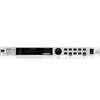Behringer FEEDBACK DESTROYER PRO DSP1124P Manual - Page 9
Using the FEEDBACK DESTROYER PRO in the FOH mix - how to connect
 |
View all Behringer FEEDBACK DESTROYER PRO DSP1124P manuals
Add to My Manuals
Save this manual to your list of manuals |
Page 9 highlights
FEEDBACK DESTROYER PRO DSP1124P Fig. 2.1: Using the DSP1124P in the monitor sends 2.3 Using the FEEDBACK DESTROYER PRO in the FOH mix Since you want to make sure that deliberately produced feedback signals, such as “guitar feedback”, are not eliminated, you should try inserting the DSP1124P into those channels that are susceptible to feedback. For example, you could process a vocal microphone that is liable to produce feedback by connecting the DSP1124P to the insert points of the respective channel. Fig. 2.2: Using the DSP1124P for specific mics (connecting the FEEDBACK DESTROYER PRO in either channel or sub-group inserts) + When processing a microphone signal with the DSP1124P and a compressor inserted into the same channel insert point, the FEEDBACK DESTROYER PRO should always be used pre-compressor: in this way, the signal is taken at the insert jack, passes the DSP1124P, then the compressor, and is finally routed back to the insert jack. Ideally, your mixer has sub-groups with dedicated insert points to connect the DSP1124P! Route all channels that are susceptible to feedback (e.g. all vocal mics) to one sub-group. While the other signals (e.g. line level signals, low-level instrumental mics) pass unaffected, all critical microphone channels are monitored by the DSP1124P. If your mixer has no sub-group inserts, we recommend that you connect the DSP1124P as follows: connect the sub-group output to one input on the DSP1124P, and the corresponding output to a free line input of a mixing console channel or one of the Aux Return inputs on the console. As long as ENGINE L and ENGINE R are not linked, you would even have the second channel of your FEEDBACK DESTROYER PRO free for other applications (e.g. channel inserts). 2. APPLICATIONS 9















